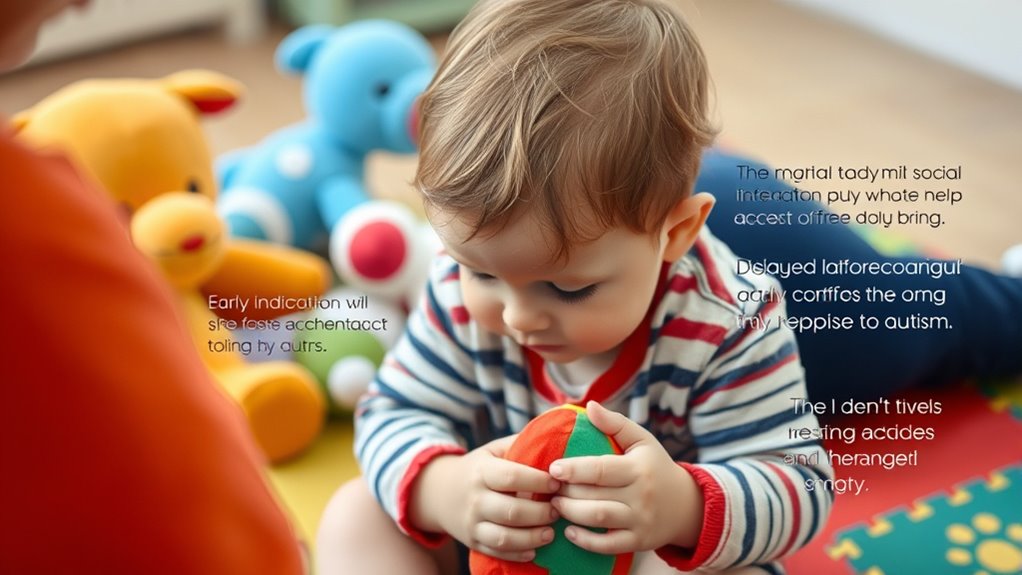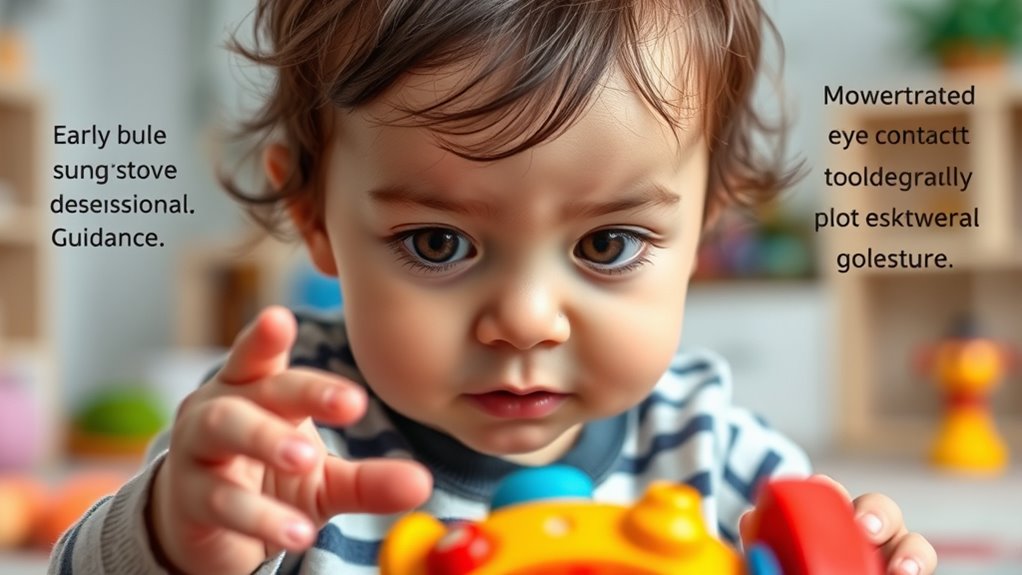If you notice your toddler struggles with communication, avoids eye contact, or shows limited interest in social interactions, these could be early signs of autism. Watch for repetitive behaviors, intense interests, or sensitivities to sounds and textures. If behaviors persist or seem unusual, it’s important to consult your pediatrician for screening and support options. Knowing what to look for can help you take timely steps—keep going to find out more about next actions.
Key Takeaways
- Watch for delays in language development, limited gestures, and difficulty responding to their name.
- Observe social behaviors like eye contact, sharing, or interest in peer interactions.
- Notice repetitive movements such as hand-flapping, rocking, or intense focus on specific objects.
- Pay attention to unusual sensory responses, like covering ears or avoiding certain textures.
- Seek professional evaluation if signs persist, including pediatric screening and developmental assessments.
Recognizing Communication Differences

Recognizing communication differences is a crucial step in identifying early signs of autism in toddlers. Pay attention to their language milestones—are they reaching typical speech and understanding benchmarks for their age? Some toddlers may delay talking or struggle to use words and gestures appropriately. Additionally, observe their attention span during communication. Does your child seem easily distracted or uninterested in social interactions? They might not respond to their name or show limited interest in sharing experiences. These signs can indicate challenges in processing or engaging with language. Noticing such differences early helps you understand whether your child is developing typical communication skills or needs support. Early intervention can remarkably improve their ability to connect and communicate effectively as they grow.
Observing Social Interaction Patterns

Pay close attention to how your toddler interacts with others, as social engagement is a key indicator of development. Observe their playground behaviors—do they approach other children, share toys, or respond to peers’ attempts to play? Notice if they seek out social situations or seem uninterested. During peer interactions, look for signs like eye contact, reciprocal smiling, or trying to initiate conversations. Some children may avoid eye contact or stay apart from others, which can be an early sign of autism. Consistent patterns of limited social engagement or difficulty connecting with peers should be noted. These behaviors can help you determine whether your toddler’s social development is on track or if further evaluation may be necessary. Color accuracy in visual cues can also influence how children perceive and respond to social stimuli, highlighting the importance of observing their overall engagement and responsiveness.
Noticing Repetitive Behaviors and Interests

Repetitive behaviors and focused interests are common in many toddlers, but noticing persistent patterns can be be an early sign of autism. You might observe stereotyped movements, like hand-flapping, rocking, or spinning, that occur frequently and seem involuntary. Additionally, your child may develop intense interests in specific objects or topics, often fixating on them for long periods. These behaviors can stand out because they are more rigid and persistent than typical toddler curiosity. While some repetition is normal, ongoing stereotyped movements and unusually focused interests may signal the need for further evaluation. Paying attention to these patterns helps you recognize early signs and discuss concerns with a healthcare professional, enabling timely support and intervention. Moreover, repetitive behaviors can sometimes be linked to sensory sensitivities common in children with autism, highlighting the importance of a comprehensive assessment.
Monitoring Sensory Sensitivities

Paying attention to how your toddler responds to sensory experiences can reveal important early signs of autism. Children with sensory processing differences may be hypersensitive or hyposensitive to sounds, sights, textures, or smells. You might notice your toddler covering their ears in noisy environments or avoiding certain textures during play. Sensory overload can cause them to become overwhelmed, leading to tantrums or withdrawal. Watch for signs that your child reacts intensely or strangely to sensory input, as this may indicate sensory sensitivities associated with autism. Monitoring these responses helps you understand their unique sensory profile and can guide you in creating a supportive environment. Recognizing sensory sensitivities early can facilitate tailored strategies to help your toddler manage sensory overload effectively. Sensory sensitivities can vary widely among children with autism and understanding them is crucial for providing appropriate support. Additionally, understanding sensory processing differences can help caregivers implement effective coping mechanisms and environmental adjustments, which are essential components of sensory integration therapy. For example, being aware of headphone compatibility can assist in selecting suitable noise-canceling headphones to reduce sensory overload. Being informed about credit card security measures can also help in protecting personal information during online transactions related to healthcare or therapy services.
Knowing When and How to Seek Professional Support

Recognizing the signs that your toddler may need professional support is essential for early intervention. When you notice persistent developmental concerns or atypical behaviors, it’s time to consider seeking help. You can start by discussing your parental concerns with your pediatrician, who may recommend screening tools to assess your child’s development. These tools help identify areas needing further evaluation and guide next steps. Look out for red flags such as limited eye contact, delayed speech, or repetitive behaviors. To ensure timely support, think about these actions:
Early signs like limited eye contact or delayed speech warrant prompt professional evaluation and support.
- Share your concerns openly with healthcare providers
- Request formal screening assessments
- Seek referrals to specialists like developmental pediatricians or therapists
- Stay informed about early intervention programs available in your area
- AI in Education advancements are also being explored to provide tailored learning support for children with developmental needs, which may complement traditional intervention methods.
- Being aware of early diagnosis benefits can motivate prompt action to support your child’s growth.
- Additionally, understanding the signs of autism can help parents recognize subtle cues that may otherwise go unnoticed.
- Consulting with early childhood specialists about behavioral assessments can further clarify your child’s developmental status.
Taking these steps can make a significant difference in your toddler’s developmental trajectory.
Frequently Asked Questions
Can Early Signs of Autism Vary Between Boys and Girls?
You might notice gender differences in autism symptoms, as boys and girls often show varied symptom presentation. Boys tend to display more obvious behaviors like repetitive actions, while girls might conceal or mask their signs better. Recognizing these differences helps you understand that autism can look different across genders, and staying attentive to subtle cues in both boys and girls ensures early support and intervention, which can make a significant difference.
Are There Specific Developmental Milestones to Watch For?
You should watch for developmental milestones like speech delays, social interactions, and play skills. When your toddler struggles to use words or phrases, avoids eye contact, or doesn’t engage in typical social play, these are signs to note. Pay attention to how they respond to their name, share interests, or imitate actions. Recognizing these milestones helps you understand their progress and when to seek guidance from a healthcare professional.
How Accurate Are Early Autism Screening Tools for Toddlers?
You wonder how accurate early autism screening tools are for toddlers. Keep in mind, screening limitations mean they’re not perfect and can produce false positives, meaning some children may be flagged incorrectly. While these tools help identify concerns early, they’re just part of the process. Always follow up with a professional for a detailed evaluation, ensuring an accurate diagnosis and appropriate support if needed.
What Age Is Best for Initial Autism Assessment?
You should consider an initial autism assessment around age 18 to 24 months, as this timing balances early detection with assessment accuracy. Diagnostic challenges exist, but early assessment can lead to better support. Waiting too long might delay intervention, so trust your child’s development and consult with specialists when you notice concerns. Early assessment helps identify needs sooner, giving your child the best chance for positive outcomes.
Can Early Intervention Improve Long-Term Outcomes for Autistic Children?
Early intervention can considerably improve long-term outcomes for autistic children by addressing developmental needs early on. Genetic factors and social influences play a role in autism’s development, so timely support helps optimize skills and reduce challenges. By acting early, you give your child a better chance to develop communication, social, and daily living skills, setting a foundation for greater independence and quality of life as they grow.
Conclusion
By paying attention to communication differences, observing social interactions, noticing repetitive behaviors, and monitoring sensory sensitivities, you can catch early signs of autism in your toddler. Recognize the patterns, understand the signals, and trust your instincts. When you notice these signs, seek support, seek guidance, and seek answers. Early action helps you support your child’s development, early intervention, and brighter futures. Trust yourself, stay informed, and take the next step with confidence.










